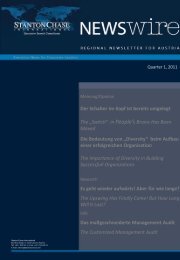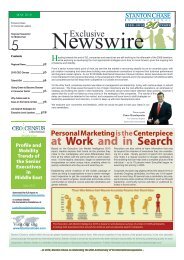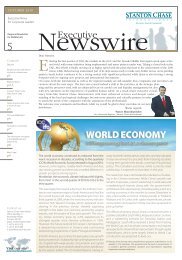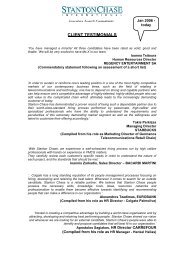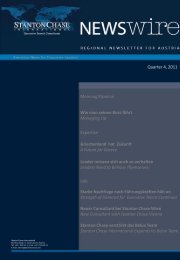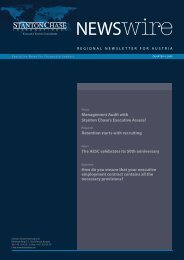Executive Newswire - Regional Newsletter for Middle East
Executive Newswire - Regional Newsletter for Middle East
Executive Newswire - Regional Newsletter for Middle East
Create successful ePaper yourself
Turn your PDF publications into a flip-book with our unique Google optimized e-Paper software.
S T A N T O N C H A S E I N T E R N A T I O N A L<br />
End of Global Recession<br />
ISSUE 2<br />
Economists say the US economy will be growing again by next year and lead the way to global<br />
recovery. The end of the recession is in sight, and will be led by the recovery in the US and<br />
China, followed by Europe, leading economists <strong>for</strong>ecast during the World Retail Congress.<br />
> Speaking at this Congress, Mirae Asset chief<br />
global and Asia strategist Ajay Kapur <strong>for</strong>ecast<br />
that the recession would end in the US in the<br />
next “few months”, followed by China.<br />
> Deloitte director of global research<br />
Dr Ira Kalish said that recovery is “all about<br />
the US and China”, which have shared a “symbiotic<br />
relationship” over the past decade. “By<br />
the end of the year or early next year, we will<br />
see the US economy growing again”, said<br />
Kalish. He added that as a result of the downturn<br />
the US will shift from consumer spending<br />
to exports, investments and government<br />
spending, whereas Asia will shift away from<br />
exports towards consumer spending. Kalish<br />
praised countries that had taken strong policy<br />
measures including quantitative easing to<br />
boost confidence, and criticized Europe’s “insufficient”<br />
policy response to the crisis and<br />
lack of strong fiscal stimulus.<br />
comment by<br />
Dr Ira Kalish,<br />
director of consumer business,<br />
Deloitte Research<br />
Retail Week, Issue 2, World Retail<br />
Congress, May 2009<br />
> Meanwhile, Li & Fung managing director<br />
Dr William Fung warned against repeating<br />
history and creating trade barriers – a method<br />
employed in the depression of the late 1920s.<br />
He said: “The only silver lining I see is we are<br />
now operating on unprecedented lower levels<br />
of inventory and trading will be sharper. What<br />
my customers are telling me is keep inventories<br />
low, let’s chase business and have a quick<br />
response.” He said that a consensus was <strong>for</strong>ming,<br />
given the resultant imbalance of power in<br />
favour of buyer over seller, that the idea of payment<br />
within 30 days on open account is “very<br />
prevalent”. However, “once you go past 60<br />
days you are giving the retailer working capital<br />
to finance the product” leading to a lack of<br />
credit in the supply chain, he added. Fung also<br />
said he expected prices to decrease by between<br />
5 and 10 per cent as commodity prices<br />
continue to fall.<br />
Light at the end of the tunnel<br />
In the first few months of 2009, the financial<br />
crisis that began with<br />
the collapse of the US housing<br />
market has deepened<br />
and become a truly global<br />
recession.Economic activity<br />
in the US, Europe and<br />
Japan has declined at an<br />
alarming rate. Emerging<br />
countries have experienced<br />
sharp drops in<br />
economic activity. Even the BRIC<br />
economies, which at one time seemed<br />
relatively immune to the global financial<br />
situation, have experienced serious problems. Global<br />
trade has plummeted, causing concern that the increasingly<br />
global nature of the economy leads to<br />
more rapid transmission of trouble than in the past.<br />
And yet, there are indications of light at the end of the<br />
tunnel. Global shipping rates have stabilized, risk<br />
spreads are far below their level of a few months ago,<br />
and governments have been pumping money into<br />
the system at an unprecedented rate. In the US, housing<br />
turnover and refinancing are accelerating, setting<br />
the stage <strong>for</strong> a rebound in consumer spending. In<br />
China, a massive fiscal stimulus is fuelling an investment<br />
boom while consumer spending remains surprisingly<br />
strong.<br />
What, then, can be reasonably expected in<br />
the next year and beyond?<br />
(from the Retail Week, Issue 2, of the World Retail Congress, May 2009)<br />
p7<br />
>Toys R Us chairman and chief executive<br />
Jerry Storch said that the “essential” rule by<br />
which retailer should trade through the downturn<br />
was “know thyself”. “We don’t know how<br />
long the recession will last,” he said. “We need<br />
to get back to the basics and get back to common<br />
sense.” He added that he had seen a<br />
“change to cheap” at the expense of quality<br />
and warned against short-termist responses.<br />
>Etam chief executive Richard Simonin said<br />
that the beginning of the end of the “average<br />
customer” had begun be<strong>for</strong>e the global<br />
downturn but that recessionary factors had<br />
sped up the evolution. He said that it was essential<br />
<strong>for</strong> retails to know their customer and<br />
be honest with their teams.<br />
A likely scenario is that the US will experience a revival<br />
of growth by the end of this year. China, which will<br />
not experience a recession but merely a slowdown,<br />
will rebound by late 2009. These two countries can<br />
then lead the world out of recession. Europe and<br />
Japan will rely on renewed US and Chinese demand<br />
<strong>for</strong> their own recoveries. As the global economy recovers,<br />
oil and other commodity prices will rise,<br />
thereby allowing commodity dependent countries<br />
such as Russia to recover as well.This is merely a likely<br />
scenario, not a firm <strong>for</strong>ecast on which to bet the farm.<br />
Still, the business cycle has not been repealed and recovery<br />
at some point in time is a near certainty.<br />
Moreover, although this is the deepest global downturn<br />
since the Great Depression of the 1930s, policymakers<br />
are reacting far differently than their<br />
predecessors of 80 years ago. Policy-makers in the US,<br />
UK and China have been aggressive in boosting demand.<br />
Thus, there is some cause <strong>for</strong> optimism. When<br />
the global economy recovers, retailers will face a new<br />
world. The US will no longer be the engine of global<br />
consumer spending growth. Americans will save<br />
more and borrow less. Their spending will be constrained<br />
by their incomes – a novel concept of late.<br />
Instead, US growth will come disproportionately from<br />
exports, investment and government. Meanwhile,<br />
Asian growth will shift away from export dependence<br />
toward growth based on domestic demand.<br />
For the world’s leading retails and their suppliers, a<br />
disproportionate share of future growth will come<br />
from the <strong>East</strong>. For retails in the US, UK, Sanin and<br />
other countries recovering from housing bubbles,<br />
growth will come from gaining market share rather<br />
than riding a consumer spending boom.





